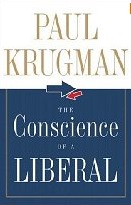Some of the reads enjoyed here over the last year, and recommended to you, from Ridenbaugh Press. Let us know what you think - and what else we should be reading . . .
 |
Overtreated: Why Too Much Medicine Is Making Us Sicker and Poorer by Shannon Brownlee (Bloomsbury, 2007). The counter-intuitive title pretty much says it. Yes, the lack of health insurance is an enormous problem; the lack of affordable health care generally is even bigger. But a key part of the problem has to do with some of the reasons that hideously expensive system is so expensive, and it includes a lot of treatment that shouldn't be. This is a subject this space will return to in the months ahead, and health care reform is highly likely to be a major theme of the months ahead; and this investigative book is excellent reading meantime about what should be an important part of all that. A whole lot of what is done in the name of our health isn't making us healthier, and we nationally need to come to grips with that. Soon.
 |
The Appeal by John Grisham (Delta, 2008). It's one of his legal potboilers (which tend to be not quite as well written as his off-track books), but few books this year hit harder politically. Few overt polemics made the case so well; this is a classic case of using fictional characters to lay out a story that has the full ring of truth, the kind of function that has a long (even honored) history. It may be a thriller, but it's also one of the best political books of the year, and you need look nowhere further than the recent history of the contests for the Washington Supreme Court to see why. Grisham here is angry - he lets no one off the hook, most especially voters who too often don't know enough about what they're doing.
 |
Snow Falling on Cedars by David Guterson (Vintage, 1995). Yes, this novel has been around for years, and yes, it's already gotten lots of kudos. But we just got around to it this year, and glad for it. The story is well told, the characters thoughtfully deepened and rounded, but what sticks most are the atmosphere and the feelings. Set in the Northwest (mostly in the San Juan islands), it has a lot to say about this region, without explicitly going there - it has a well-drawn background, but that's not its core subject. Its take on community relations, and how even the islands among our communities are globally linked, are both timeless and timely. This can be one of those books that changes the way you look at the world, and (maybe more than that) your neighbors.
 |
Have a Nice Doomsday by Nicholas Guyatt (Harper Perennial, 2007). The back cover notes: "50 million Americans have come to believe that the apocalypse will take place in their lifetime." The background of that, and the myriad implications how this country is run, unspool in this book, written with a light touch - it isn't the slash job you might expect. There's humor scattered throughout, and Guyatt's tone is a little bemused (he's no true believer, just a student of those who are), but he plays fair. This book is about a whole large part of the country the traditional mass media rarely treat, and rarely know how. They (and the blogosphere, for that matter) could take a few lessons from Guyatt's approach.
 |
Lincoln, President-Elect by Harold Holzer (Simon & Schuster, 2008). The subtitle is, "Abraham Lincoln and the Great Secession Winter 1860-61," and that's what it covers - and argues about. There's been a strain of historical thought, starting contemporaneous with Lincoln, that he mishandled, dealt too loosely, with the secession crisis during the months between his election and inauguration. This book, by a writer of numerous Civil War era histories and researched to intricate detail, makes an excellent case that Lincoln played the few cards available to him far better than most people thought, or still do think. This book, surprisingly timely, might be therapeutic for the currently hyperventilating among us.
 |
The Conscience of a Liberal by Paul Krugman (WW Norton, 2008). This came out some months before Krugman won the Nobel, and his subject is mostly politics, not economics, though Krugman expertly weaves the two of them, and makes the (academic, without getting abstruse or pedantic) case for how economic and politics have had a direct effect on each other. You needn't agree with everything he says to find the book useful. More than any other of the year (that we've read), this one outlines the world view and the case for the governing just now coming into power, his early 2008 squabbles with Barack Obama notwithstanding. You'll pick up some useful history, some useful economics, a statistics lesson or two, and more along the way.
 |
Obama: From Promise to Power by David Mendell (Amistad, 2007). The two self-penned Obama books are worth the read (for different reasons), but if you want an informed outsider's take on the man, this is a good option. Mendell was a Chicago Tribune reporter from 1998 to 2004, and covered Obama closely during most of that time; he's familiar with the background, and he knew the man pre-fame. The book dishes little real dirt, although it amply covered almost everything that came out this year about Jeremiah Wright and other Chicago hot spots - none of those came as a surprise to anyone who read this early in the year. But it feels well grounded. There's a little too much self-referential press material in it, and the book ends just before the '08 presidential really kicked in. But this one may stand for a while as a solid backgrounder on the next president.
 |
1960: LBJ vs. JFK vs. Nixon: The Epic Campaign That Forged Three Presidencies by David Pietrusza (Union Square Press, 2008). This doesn't seem quite like the definitive take on the subject that it might have been, that Theodore White's once seemed to be. But it covers such a mass of detail, full of so many neatly-observed pieces, that it belongs in the upper ranks of campaign books. Reading it this fall, as the presidential campaign hit its mid stages, it seemed especially appropos - the linkages kept popping up. Good history almost always repays reading; you never know where the lessons will reapply.
 KVI in Seattle
KVI in Seattle










 Car status in western Oregon/Stapilus
Car status in western Oregon/Stapilus
